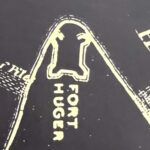The Apalachee Batteries, Huger and Tracey, represent the importance of Mobile, Alabama’s estuary to the city’s defenses. During the American Civil War, Federal authorities sought to occupy southern and central Alabama, with Montgomery as the ultimate objective point of the 1865 invasion. With its year-round river and railroad communication in the heart of Alabama. The loss of Mobile would not only further dampen the Confederacy’s waning morale but also deal a mighty military blow.
Early Spanish and French explorers noted the “land-locked” Mobile Bay region featured natural defensive advantages. In the mid-nineteenth century, Mobile’s unique geographical factors caused the Federals to be apprehensive about attacking the city earlier in the war. A vast marsh to the north of the city extending to Three-Mile Creek made it nearly impossible for an enemy force to attack from that direction.[1]
Mobile Bay posed unique challenges to an invading fleet. Before the shipping channel was dredged in 1854, the Dog River Bar limited vessels at Mobile to a maximum draft of 8 feet. In 1854, a channel was dredged to allow vessels to pass over the Dog River Bar with a draft of 10 feet. “It has been difficult to approach Mobile at any time on account of the peculiar indentations of its water courses,” reported the Cincinnati Enquirer on April 21, 1865, “and of the fact that an enormous sand-bar in the bay has long prevented ships, except of the lightest draft, from reaching its docks.” Vessels with drafts of 13 feet could travel up to Montrose, which was about 9 miles southeast of Choctaw Point. Union Admiral David Farragut’s flagship, the USS Hartford, had a draft of 17’2” and could not get any closer than 22 miles of Choctaw Point. [2]
Prior to the American Civil War, the two forts, Morgan and Gaines, were deemed sufficient guardians of the entrance to Mobile Bay. Nevertheless, Confederate military engineers still determined that further fortifications were needed in the event the U.S. Navy successfully penetrated the lower bay defenses.
The Apalachee Batteries, Huger and Tracey, were the first upper Confederate Civil War earthen fortifications built near the eastern shore in the Mobile Bay Delta. The batteries were constructed in the marsh at the Apalachee and Blakeley Rivers junction during the war. They were designed to serve as artillery platforms with some basic land defense. Their primary objective was to control the strategic waterways of the Blakeley and Apalachee Rivers to prevent Federal gunboats from advancing during the American Civil War. Constructed with enslaved labor, the remnants of these fortifications mark the location of one of the last battles of the Civil War. The two batteries on the Apalachee River were Mobile’s last defenses to yield. [3]
The basic architectural design of these forts followed the principles of earthen fortifications taught at West Point and detailed in Dennis Hart Mahan’s Treatise on Field Fortifications. The Apalachee Batteries are an example of the engineering system used by both sides of the conflict, which was applied to strategic locations, including the harsh swamp areas of Mobile’s delta. The location and architecture of these forts provide an important tangible link to Alabama’s Civil War history, while their engineering reflects the shared national history of both sides of the Civil War. Moreover, the Apalachee Batteries preceded Fort Blakeley, which has been listed and identified as a historically significant place. [4]
[1] “Mobile,” Philadelphia (PA) Inquirer, February 14, 1865, 2; “Yankee Accounts from Mobile,” Raleigh (NC) Daily Progress, February 22, 1865, 2.
[2] “Mobile,” Philadelphia (PA) Inquirer, February 14, 1865, 2; “Yankee Accounts from Mobile,” Raleigh (NC) Daily Progress, February 22, 1865, 2; “Fall of Mobile and Defenses,” Cincinnati (OH) Enquirer, 2; “Department of the Gulf,” New York Times, March 20, 1865, 8, Kirk Barrett, Mobile Bar Pilot, Email interview, April 10, 2024.
[3] A battery is a fortified emplacement for heavy guns. John Weaver, Email interview, January 20, 2024.
[4] Dennis H. Mahan, A Treatise on Field Fortification, Containing Instructions on the Methods of Laying Out, Constructing, Defending, and Attacking Intrenchments, with the General Outlines Also of the Arrangement, the Attack and Defence of Permanent Fortifications (1856); John Weaver, Email interview, January 20, 2024; Mike Bailey, Email interview, March 5, 2024.
